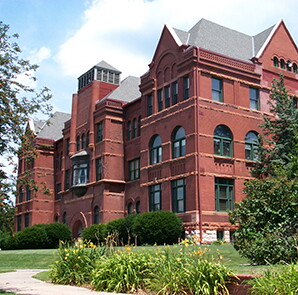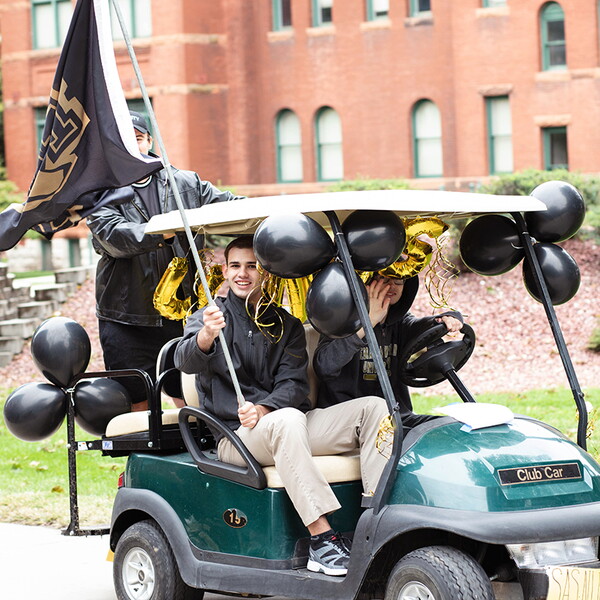Vehicle Safety Policy
|
Policy title
Vehicle Safety Policy
|
Category
Administration
Business Office
Human Resources
Omaha Instructional Site
Public Safety/Risk Management
Travel and Off Campus Activities
|
|
Owner
Business Office
|
Approved by
Administrative Council
|
A basic component of the Nebraska Wesleyan University (NWU) risk management program is a vehicle policy which establishes the safety guidelines for its authorized drivers when driving for institution business. The following guidelines have been established to manage the risk and ensure the safety of our students, faculty and staff.
This policy applies to all NWU departments covering the qualifications and operation of personal, owned, leased or rented vehicles by those who regularly drive on NWU business.
Faculty and staff who occasionally drive on institution business and not transporting students – see paragraph H
Vehicle Safety Policy
- Driver’s License
- All NWU faculty, staff and students who drive a vehicle during NWU operations must have a valid driver’s license appropriate for the type of vehicle they will be driving.
- Employee’s who regularly drive on institution business will provide a copy of the driver’s license.
- Motor Vehicle Record
- All employees and student drivers who regularly drive will complete and sign a Consent to Check Nebraska Motor Vehicle Record (MVR) form allowing NWU to obtain a MVR. If employee has an out of state driver’s license they must obtain motor vehicle record at their own cost and provide it to the business office every 12 months.
- It is the responsibility of the driver to report any changes in the status of their driving record.
Only drivers with a good driving record are allowed to operate institution vehicles or vehicles rented for institution business. If a driver’s record contains one of the following violations within the past three (3) years, he/she is ineligible to drive:
- Driving under the influence of alcohol/drugs
- Failure to stop/report an accident
- Reckless driving
- Driving while impaired
- Making a false accident report
- Homicide, manslaughter, or assault arising out of the use of a vehicle
- Driving while license is suspended/revoked
- Racing
- Attempting to elude a police officer
- Three or more separate driving infractions (i.e. speeding, no driver’s license, etc).
Note: On a case-by-case basis, this rule may be temporarily over-ridden by specific authorization of the Vice President for Finance and Administration. Any exceptions must be in writing and maintained in the driver’s personnel file.
- Authorized Drivers List
- All department heads will identify an individual to manage the driver program within their department and maintain a list of authorized drivers.
- Athletics
- Admissions
- Advancement
- President’s Office
- Facilities
- Academic Affairs
- If there are vehicles which need special certifications to be driven, e.g. CDL, the authorized drivers for those vehicles will be identified.
- All department heads will identify an individual to manage the driver program within their department and maintain a list of authorized drivers.
- Assigned Vehicles
Some vehicles may be assigned to individuals as part of their job duties, such as the President, Vice President for Advancement and others. These employees should operate and maintain these vehicles as though they were their own. Loaning vehicles to unauthorized users, hiring it out to others, using it to advertise outside companies, or any other enterprise not approved by the institution is strictly prohibited. - Key Control
- Driver will request the use of a vehicle from the department or reserve on the on-line reservation calendar and provide a time for someone to pick up the keys.
- When the request is received, the department will:
- verify that the driver has his/her valid driver’s license,
- MVR has been completed,
- driver has completed a driver safety program, if necessary. See requirements below.
- All vehicles and keys must be returned to the appropriate department within the next business day of returning to the campus.
- Loaning vehicles to unauthorized users, hiring it out to others, using it to advertise any outside companies, or any other enterprise not approved by the institution is strictly prohibited.
- 15-Passenger Vans
Given the increased safety risk of 15-passenger vans in general, NWU has elected to ban the use of these vehicles for institution travel. - 12–Passenger Vans
- Only NWU faculty, staff and students who are 21 years of age or older may drive a passenger van while on University business.
- The occupancy of the van may not be more than 12 persons, including the driver.
- No roof racks may be used. Trailer towing is not allowed on passenger vans.
- The passenger van policy applies to vans rented for business as well as those owned by NWU.
- Travel will not be allowed during state issued travel advisories.
- On-line 15-Passenger Van Safety training is required. (See below)
- Personal Vehicles (Occasional Use; no Student Transportation)
- Drivers who occasionally drive their personal vehicles are subject to the NWU – Travel and Expense Reimbursement Policy.
- All NWU faculty, staff and students who drive a vehicle during NWU operations must have a valid driver’s license appropriate for the type of vehicle they will be driving.
- Drivers must provide evidence if asked of auto liability insurance that meets or exceeds the state minimum requirements.
- All personal vehicles used for institution business must be maintained per manufacturer’s recommendations, in compliance with all state laws, and be presentable with clean interiors and exteriors.
- Student Drivers
- Any student whose duties may require him/her to operate an institution vehicle will meet the same criteria as an authorized employee driver.
- If transportation for students is being organized by NWU and the student is driving a NWU-owned or rental vehicle an NWU employee or authorized volunteer must be present in the vehicle.
- Volunteer Drivers
NWU does not allow volunteers to drive for institution travel, unless approved by the Vice President for Finance and Administration. Employee driving requirements will also apply to volunteers. - Disciplinary Protocol
An authorized driver’s driving record will be reviewed every 12 months. The driver may be subject to discipline by the supervisor and Human Resource department if the infraction limits the employee’s completion of their job duties.
II. Training
- Driver Training
In order to understand the responsibilities and techniques for driving safely, all drivers must be trained in the appropriate techniques. This training will be provided by your department via the on-line course.- Training is required via the Vector Solutions (see below) online course.
- Defensive Driving (21 minutes)
- 15-Passenger Van Safety – for driving 12-Passenger van (19 minutes)
- New employees who drive frequently for their job will watch the Defensive Driving on-line course at the time of hire or initial authorization. Human Resources will notify the department if the employee is considered a regular driver. NOTE: Current regular drivers do not need to complete the initial training requirements.
- Any driver that has a violation recorded through the annual MVR review, must complete the Defensive Driving course.
- All student drivers are required to complete the Defensive on-line course during each school year they are eligible to drive an institution vehicle. The training should be completed prior to their first use of the vehicle in the school year.
- All employees and students driving passenger vans must complete the 15-Passenger Van Safety on-line training for driving 12-Passenger vans.
- All employees and students will document their training by signing the attendance sheets via the on-line training.
- Training is required via the Vector Solutions (see below) online course.
III. Pre-Trip Safety
- NWU-Owned Vehicle Inspection
- The driver will complete and sign the Pre/Post-Trip Vehicle Inspection form indicating that they have inspected the vehicle.
- Headlights, taillights and windows must be clean before operating the vehicle.
- The driver should also verify that a copy of the accident report form and current insurance card are available in the vehicle.
- Upon return from the trip, the driver will return the completed copy of the Pre/Post-Trip Vehicle Inspection form to the appropriate office when turning in the vehicle keys. The appropriate office and the driver will review and update a brief vehicle inspection using the Pre/Post-Trip Vehicle Inspection form and document any mechanical problems with the vehicle, service required, new damage, the amount of gas added, the number of miles driven and any service that may have been provided to the vehicle. The vehicle must be returned with a full tank of gas.
- The driver will complete and sign the Pre/Post-Trip Vehicle Inspection form indicating that they have inspected the vehicle.
- Maintenance
In order for NWU vehicles to have a long and useful life, they must be maintained regularly. Accordingly, we have established a Preventive Maintenance Program to include all institution’s vehicles and equipment.- Each department will maintain a list of institution vehicles. The list will include the manufacturer’s recommended intervals for preventive maintenance services, as well as the dates/times and types of services that have been performed on the vehicles.
- For vehicles assigned to one person or department for their exclusive use, such as the President or Vice President for Advancement, the user will then be responsible for having the maintenance services completed and documented.
- If a vehicle has operational problems while off-campus, the driver will notify the department. If the vehicle cannot be operated safely, the department will make the necessary arrangements to bring the driver back to campus and have the vehicle transported to a designated service location.
- Rental Vehicle Insurance
- When driving in the United States, its territories and possessions, and Canada, do not purchase rental vehicle insurance.
- When driving in countries other than the United States, its territories and possessions, and Canada, rental vehicle insurance must be purchased.
- When driving to Mexico in an institution owned vehicle, additional auto insurance must be purchased before travel begins.
- Limit Passengers
Driver will not transport people who are not involved in the institution’s business.
IV. Trip Safety
- Entering and Exiting Vehicle
When entering or exiting the vehicle, driver and passengers should be careful to watch for oncoming traffic or other threats that may pose damage to the vehicle or driver including an awareness of the increased potential for slip, trip and fall incidents. - Seat Belts
Seat belts are one of the most important pieces of safety equipment installed on a motor vehicle. Thus, it should be noted that the use of seat belts is entirely under the control of the driver.- When going on a trip (even a short trip across town), ensure that there is a seat belt for every passenger. If not, limit the number of passengers to the number of seat belts available.
- Before shifting from “Park,” the driver must secure his/her seat and shoulder belt and verify that all passengers are appropriately secured by their seat and shoulder belt.
- Alcohol and Drugs
It is important for all drivers to recognize their responsibilities for operating an institution vehicle in a safe and sober manner. We require each driver to sign a commitment statement in which he/she pledges to comply with all applicable federal, state and local regulations regarding drug and alcohol use, including institution policies, when operating any vehicles for institution business. No driver authorized by the institution should be under the influence of alcohol or drugs while operating an institution owned vehicle at any time. - Cellular Phones and Electronics
Cellular phone and other electronic device use by the driver while the vehicle is in motion is strictly prohibited. Cell phones may only be used to make calls through the assistance of Bluetooth or other hands-free devices. Headphones that reduce hearing should not be used. For navigation devices, program the destination before starting the vehicle, pull off the road to make changes and rely on the voice directions to guide you. - Stowed Items
- Items that can become loose during travel should be properly secured and placed in proper storage areas or separated by a cage from the passenger area to prevent injury to passengers or damage to other vehicles.
- Stowed items should not obstruct the driver’s view.
- Vehicle Theft
- To reduce the potential for theft and vandalism, the vehicle should be locked when left unattended, no valuables should be left in sight and the vehicle should be parked in a well-lit area at night.
- NWU is not responsible for personal items left in a vehicle.
- Extended Trips
To reduce the possibility of fatigue-related accidents on extended trips, when the trip is over 400 miles, at least two eligible drivers will be assigned to drive the vehicle. The drivers will rotate as a driving team every two hours. The “shot-gun passenger” will stay alert and act as co-pilot. On a case-by-case basis, this rule may be temporarily over-ridden by specific authorization of the Vice President for Finance and Administration. - Smoke Free Vehicles
Smoking or other use of tobacco products (including, but not limited to, cigarettes, pipes, cigars, snuff, or chewing tobacco) is not permitted in vehicles owned, leased, or rented by the institution.
V. Accident procedures
- Vehicle Accident Reporting Procedures
- If a vehicle driven on behalf of or owned by NWU is involved in a collision with another vehicle, object or person or a one-car accident, such as rolling over and going into a ditch, the driver should call the police and, if there are any suspected injuries to driver or passengers, request emergency medical assistance.
- Accidents that occur off or on-campus should be reported promptly to authorities and to the Business office at NWU (402) 465-2119.
- The following information should be provided:
- Driver’s name and the vehicle involved
- Location of the accident
- Description of any injuries to driver, passenger(s) or occupant(s) of other vehicles
- Indicate whether the police and/or ambulance been notified and
- Indicate the medical facility where injured people have been taken
- The following information should be provided:
- After calling, retrieve the current insurance card from the vehicle. This card shows evidence of insurance to police authorities and provides the driver with basic information on the insurance company, their claim reporting phone number and the policy number.
- Exchange basic information with the driver of each vehicle involved. Only the following information should be provided:
- Name, address and telephone number of the driver and any passengers
- Type of vehicle and license plate number
- Insurance company name and policy number



